Ship Launching Airbags
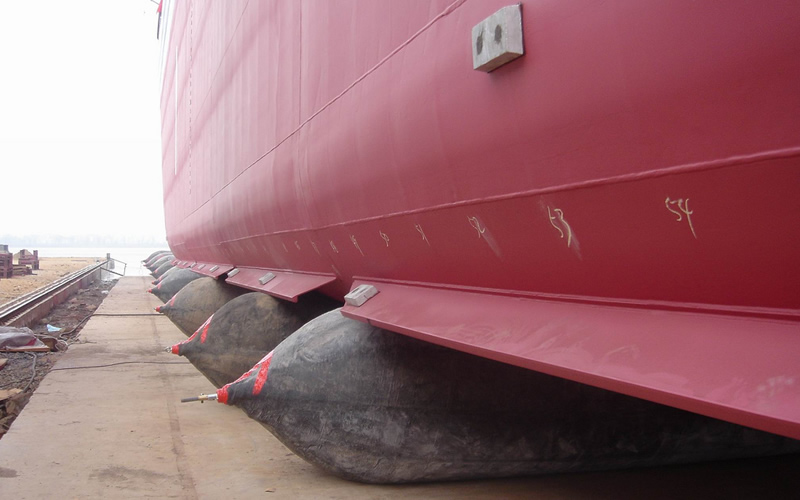
Ship Launching, Haulouts, & Salvage
ISO 14409
Ship Launching Airbags. Also known as inflatable marine airbags, roller bags, air lift bags, and salvage bags. Airbags range in size from 0.8 to 2.5m diameter, with lengths of 5.0m to 24.0m ‘effective length’. Airbags are used for ship launching, haul-outs, loading, and floating. They are widely used in cargo boat launching and landing, lifting and moving sunken ships, and salvaging stranded boats. Air bags have the benefit of not only saving labor and time, but investment costs. Additionally they are flexible, portable, and dependable.
LAUNCH UP TO 55,000 DWT!
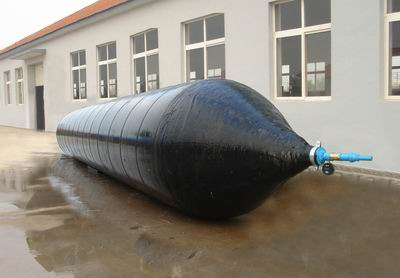
Ship Launching Airbags relieve the restrictions of traditional slide-board technology which is commonly used in building small or medium size ships, and it provides an economical alternative to expensive dry docks.
Air bags also allow for the landing of vessels in locations previously restricted only to dry docks. Years of trial and error with pneumatic roller bag technology has increased the ability of launching 100-ton ships to 13,500-ton ships!
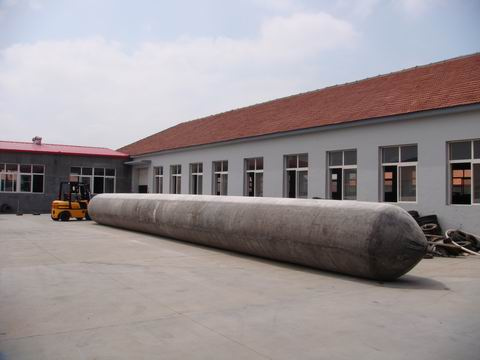

6-layer bags that are 1.5m dia x 15m long for example contain a rubber content that is not less than 51%. The air-bags can safely hold 234-tons with a safe working pressure of 0.12MPa while rolling. When standing still the highest lifting pressure is 0.14MPa while holding 272-tons.
LONGEST EFFECTIVE FLAT LENGTH IS 24.0 METERS
For price quotes – please answer the following questions:

- Type of vessel?
- LOA (length) of ship?
- Width of vessel?
- Vessel’s actual launched weight?
- What is the vessel’s DWT?
- Type of ground ship is built on? (Dirt, concrete, etc.)
- Depth where the ship first enters the water?
- What’s the angle degree of slipway? (Land)
- Please provide the low/high tide schedule at site.
- The working height? (The block stand height)
- Distance from bottom of propeller to the water level?
- Distance from back of vessel to the water entry point?
*If possible, please provide photos of the launch area.



Pictures Courtesy of:

Premier Northeast builder of double-hulled barges, tugboats, and other vessels.
www.senescomarine.com
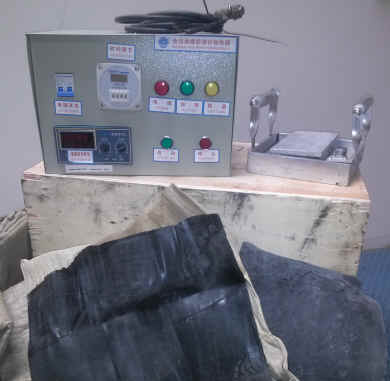
Includes: Control Panel, Steel Hot-Plate, Patch Materials

Each bag includes a valve, air pressure gauge, and end cap.
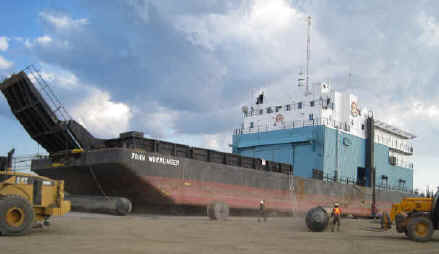
Dry docking an accommodation barge
Canadian Arctic
2200ton; Length: 250ft; Width: 70ft; Hull Depth: 14ft





Click photos to enlarge
The slope is a dirt surface with a 2 meter raise. Buried anchors and large winches with multi strand lines used to haul out the vessel that is located in the Canadian Arctic.

Pictures Courtesy of Horizon North
www.horizonnorth.ca
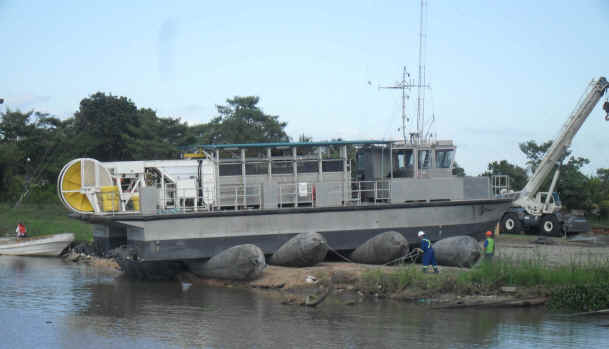


Click photos to enlarge
GEO Kinetics Launching an aluminum workboat in Mexico.

Pictures Courtesy of Allen Marine Inc
www.allenmarineinc.com






Click photos to view vessel salvage operations
Post Hurricane Katrina Vessel Salvage/Location – Rte 23 Empire, LA
90 Gross Tons; Length: 49.4m; Width: 9.76m; Hull Depth: 3.38m
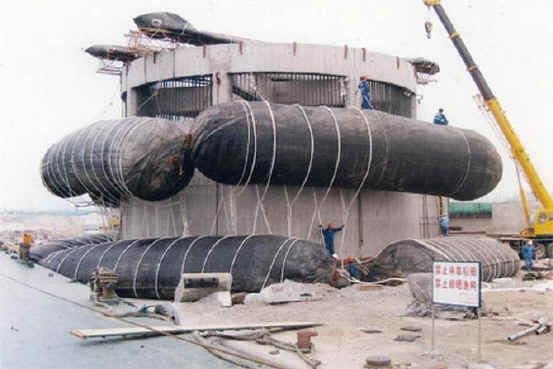
SALVAGE AIRBAGS SHIPWRECKS AND SUNKEN STRUCTURES


In order to meet the requirements for the vessel salvage and rescue industry, we have redesigned the launching airbags. These can now be used as pontoons for supporting docks and other floating structures, and they are also excellent for pipe-laying and other underwater construction projects to supply buoyancy. But the main application of the “Marine Salvage Airbags” is in shipwreck salvage, floating bridge and dock construction, rescue, and removal of wrecked ships and beached vessels.
Marine Salvage Airbags are very small in size when deflated, and are lightweight. Thus, they can be easily transported and deployed. They can be used vertically to right sunken vessels out of deep water. When the boat is suspended near the surface they can be slung under the boat with one end on each side to raise the boat high enough out of the water to pump it out. In shallow water two bags can be slung together like pontoons, one on each side of the boat. They can also be used as rollers for moving beached boats back into the water, just like our Ship Launching Airbags.
ADVANTAGES
- Special synthetic tire-cord layer material
Our “Salvage Tubes” are made with special synthetic tire-cord layers, which have much better performance than those made with PVC coated fabrics. - High-Pressure Design
Salvage Tubes have a maximum working pressure of 0.25Mpa. That means that they can be used under 25m water-depth. - Holistic Screw Type Enlacing Salvage Airbags
Our “Vessel Salvage Airbags” are a totally enclosed tube with cone ends. It is manufactured using Holistic Screw technology. This design ensures that there aren’t any welded seams. This makes them stronger than RF welded salvage airbags. - Equipped complete with accessories
Our Salvage-Bags are equipped with nylon straps and shackles with 6:1 safety factor.


For extra wide launch requirements the marine airbags can be placed side-by-side.
We ship worldwide!
Acceptance Test for Commercial Ship Launching Airbags
• The appearance of each Evergreen Maritime ship launching airbag is smooth, glossy and without blemish such as crack, blister, delamination, pits, or impurities.
• The length and diameter of each Evergreen Maritime ship launching airbags are measured with the rated working pressure and is within ±3%.
• The gas-tightness is tested without carrying any load as per ISO 14409. The pressure loss is less than 5% of rated working pressure within 1 hour.
Evergreen Maritime ship launching airbags are type approved. This means we have demonstrated the performance of ship launching airbags to independent inspectors CCS. Type Approval Test is the essential and necessary qualification of qualified manufacturer of ship launching airbags. In addition to the requirements for the material, appearance, and dimensional tolerances, “Gas-tightness Test”, “Compression Test”, “Bearing Capacity Test”, “Bursting Test”, and “Compression-recovery Test” are carried out.
Ship Launching Airbags Burst Test
All Evergreen Maritime ship launching airbags are manufactured and tested comply with ISO 14409 “Ships and marine technology – ship launching airbags“, certificated by CCS, LR, DNV. There are two more China industrial standards and one ISO standard for ship launching airbags:
— CB/T 3837-1998 Technological Requirements for ship Upgrading or Launching Relying on Airbags (Shipbuilding Industry Standard, PRC)
— CB/T 3795-1996 / CB/T 3795-2009 Air bag for ship up to or down to launching way (Shipbuilding Industry Standard, PRC)
— ISO 17682 Ship sand marine technology —Methodology for launching ship utilizing air bags.





